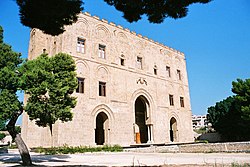History
The name of the family derives from Bartolo of Andernach, a descendant of Gerlach of the House of Wangenii of Château de Wangenbourg, since the 5th century lords of "Andermacco in Alsace" (Andernach, castle on the Rhine). Bartolo descended into Italy in 951 a.D. as "signifer" (assistant) of the Holy Roman Emperor Otto I. Returning to Germany to face the threat of the Magyars - which he defeated at the Battle of Lechfeld in 955 - the Emperor appointed Bartolo as governor ("gubernator") of Pisa. At his death, Bartolo was succeeded by his son Lucchino, called by the local population Lucchin di Noterbartolo, "Lucchino (son) of Notarius Bartolo". His descendants lived in Pisa, Siena, Perugia and other cities of medieval Italy, where they were known as knights and men of letters, intermarrying with numerous illustrious families. [2]
As a consequence of the war between the Guelphs and Ghibellines, a descendant belonging to the latter faction, Pietro Notarbartolo Farfaglia, moved in the late 13th century to Catania. Pietro, Royal Secretary of Aragonese King Frederick III of Sicily, obtained by the latter in feudum the control of the city of Polizzi.
In Sicily, the family flourished - at first in Polizzi and, later on, especially in Palermo - gaining numerous fiefdoms and titles and later subdividing in the 16th century in the two main branches of the Princes of Sciara [3] and of the Dukes of Villarosa. [4] Members of both the branches, as well as of the branch of the Princes of Furnari, were Peers of the Realm. [5]
Throughout the centuries, the House of Notarbartolo established tight familiar and economic relationships with many of the most influential Italian families. Just to mention a few, the family intermarried with the Houses of Alliata, Filangeri, Gravina, Grimaldi, Lancia, Moncada, Obizzi, Paternò, Piccolomini, Spucches, Stagno, Tomasi di Lampedusa, Valguarnera, Ventimiglia.
A distinguished representative of the family was the Marquis Emanuele Notarbartolo (1834 - 1893), mayor of Palermo and Director General of the Banco di Sicilia, widely considered as Mafia's first eminent victim in 1893. [6] One of the most important streets of Palermo is dedicated to him, as well as the Notarbartolo Railway Station.
The branch of the Princes of Sciara had as family residence in Palermo the palace of la Zisa, later expropriated by the Italian state in 1955 and appointed World Heritage Site (UNESCO) in July 2015. [7]
Both the main branches of the family of the Princes of Sciara and of the Dukes of Villarosa are still proceeding nowadays.
This page is based on this
Wikipedia article Text is available under the
CC BY-SA 4.0 license; additional terms may apply.
Images, videos and audio are available under their respective licenses.


